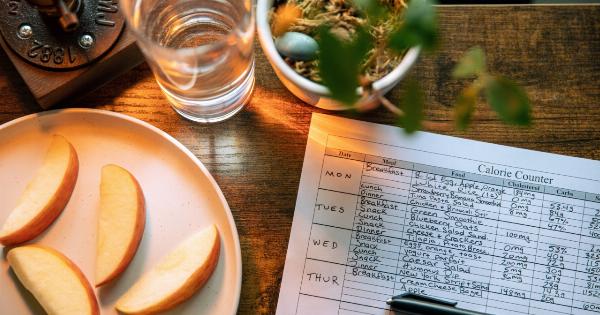Counting calories is a popular method for managing weight and maintaining a healthy lifestyle. However, many people unknowingly make mistakes when calculating the number of calories in their meals.
These errors can lead to inaccurate estimations, misleading diet plans, and hinder progress towards health goals. In this article, we will discuss some common mistakes people make when calculating calories and provide tips on how to avoid them.
Neglecting Hidden Calories
One major mistake people make is overlooking hidden calories. It’s easy to focus solely on the main ingredients of a meal and ignore the additional fats, oils, sauces, and dressings that contribute to the calorie count.
These hidden calories can significantly impact the total calorie intake. To avoid this mistake, make sure to account for all the components of a dish and consider using low-calorie alternatives or reducing the amount of high-calorie additions.
Over-relying on Package Labels
Another common error is relying solely on package labels for calorie information. While these labels provide a convenient reference, they may not always be accurate.
Manufacturers may use various tricks, such as manipulating portion sizes or using misleading serving suggestions, to make their products appear lower in calories. To ensure accuracy, it’s essential to cross-check information from reliable sources like nutrition databases or consult a registered dietitian.
Ignoring Serving Sizes
Ignoring serving sizes is a prevalent mistake when calculating calories. Many people assume that the amount they consume aligns with the serving size mentioned on the package or in a recipe.
However, portion sizes can vary significantly, leading to inaccurate calorie calculations. It is crucial to weigh or measure food portions to ensure accurate estimations and prevent overeating.
Underestimating Cooking Methods
Underestimating the impact of cooking methods on calorie count is another error made by many individuals. Frying, deep-frying, or sautéing foods in oil can significantly increase the calorie content.
Breading or battering ingredients also adds to the calorie count. It is important to account for the cooking methods used and their associated calorie additions to obtain an accurate representation of the total calories in a meal.
Not Adjusting for Preparation Techniques
People often forget to adjust for various preparation techniques when calculating calories. For example, boiling vegetables can cause some of the nutrients to leach into the water, resulting in a slightly lower calorie content.
On the other hand, roasting or grilling can cause moisture loss, making the food denser and potentially higher in calories. Understanding how different cooking techniques affect nutrition can help create more precise calorie calculations.
Misjudging Homemade Dishes
When preparing homemade dishes, it’s common to estimate the calorie content based on similar items found in restaurants or pre-packaged meals.
However, homemade recipes can significantly vary in ingredients and cooking techniques, making the estimation inaccurate. To ensure better accuracy, break down the recipe into individual ingredients, measure their amounts, and account for any variations or modifications made during the preparation.
Forgetting Liquid Calories
Many people forget to consider the calorie content in beverages, assuming they have a minimal impact. However, sugary drinks, alcoholic beverages, and even seemingly healthy options like smoothies can contribute a significant number of calories.
To avoid this mistake, read labels, opt for low-calorie alternatives, and consider reducing portion sizes or diluting high-calorie drinks with water.
Not Tracking Snacks and Condiments
Snacks and condiments can quickly add up in terms of calorie intake. Munching on small bites throughout the day without considering their caloric value can lead to overconsumption.
Additionally, condiments like ketchup, mayonnaise, or salad dressings can be calorie-dense. To avoid this mistake, measure the servings of snacks and condiments to accurately track your calorie intake.
Miscounting Exercise Calories
Some people make the mistake of believing they can eat extra calories after exercising, leading to overconsumption. The number of calories burned during exercise can be overestimated, which may result in a caloric surplus rather than a deficit.
Be cautious when using exercise to compensate for indulgent meals, as it may hinder your progress. Instead, focus on maintaining a balanced, nutritious diet.
Not Monitoring Progress and Adjusting
Avoid the mistake of not regularly monitoring your progress and adjusting your calorie intake accordingly. As your body changes and adapts to your dietary routine, your caloric needs may also change.
If you continue to eat the same number of calories as when you started, you may hit a weight loss plateau or experience a lack of progress. Regularly reassess your goals, monitor your weight, consult with professionals if needed, and make necessary adjustments to keep progressing towards your desired outcome.
Conclusion
Counting calories can be a helpful tool in managing weight and achieving health goals.
However, it is essential to avoid common mistakes that can lead to inaccurate calculations and hinder progress.
By considering hidden calories, being cautious with package labels, paying attention to serving sizes, accounting for cooking and preparation methods, accurately assessing homemade dishes, tracking liquid calories, monitoring snacks and condiments, avoiding miscounting exercise calories, and regularly adjusting your calorie intake, you can make more precise estimations and optimize your dietary journey.































